Knights and chivalry of three centuries. Knights of the south of Italy and Sicily 1050-1350
Dante Alighieri
Southern Italy and Sicily were politically and to some extent culturally separated from the rest of the country during the period under review. Sicily for a long time remained under Islamic rule, and the southern part of the peninsula - under the rule of Byzantium. That is, initially military affairs in these territories developed in line with Muslim and Byzantine military culture. However, everything changed after the Norman conquest of southern Italy and Sicily in the 1076 and 1088 years, after which it became possible to treat this region as a whole.
Naples was not officially captured until the 1140 year, but for many years the Normans also actually dominated here. Moreover, this unification occurred despite significant cultural differences between the former Islamic Sicily, the former Byzantine Calabria, Apulia, Gaeta, Naples and Amalfi, as well as the former Lombard Salerno, Benevento and Capua. True, the culture of the south experienced a strong shock after the political separation of Sicily from the south of Italy, following the famous "Sicilian vesper" 1282 year. And these two regions were not reunited until the 1442 year. However, it would be more logical, nonetheless, to consider military history The south of Italy is in total.
Battle of Benevento (1266). Guelphs vs Ghibellines *. Miniature from the “New Chronicle”, 1348, “Vatican Apostolic Library, Rome)
Well, we need to start with the fact that the duchy of Lombardy, which ruled the lands of southern Italy before the Norman conquest, had its own special military culture, dating back to Byzantine, early medieval Germanic and even Late Roman prototypes. Military service here was a purely personal matter, not related to the ownership of land. And the local aristocracy lived in cities or towns, but not in the country castles, like the elite of Northern Europe. It is believed that the Lombards who conquered Italy were not very good horsemen, but this does not mean that there were no cavalry here at all. When the Normans arrived here, they were confronted with the fact that the class of Milites (that is, professional soldiers) already existed in Naples and Bari, and, possibly, in other cities. That is, there were already warriors here, quite similar to knights, although it is possible that without castles. In the cities there were also militia military units from the townspeople.
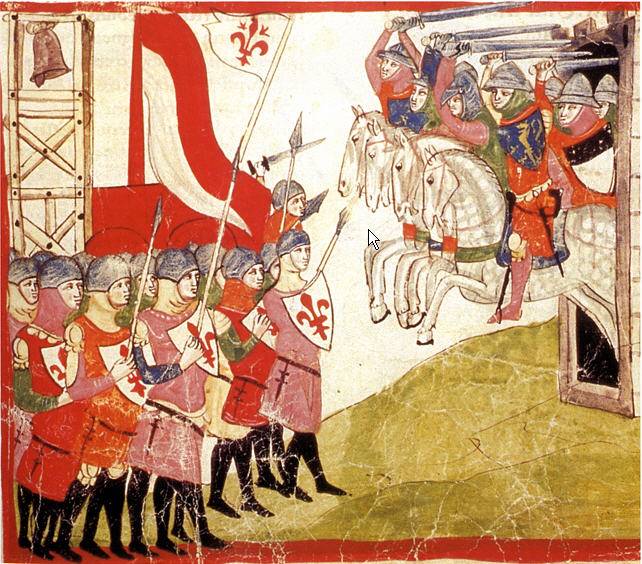
The Battle of Montaperti (1260), the work of Pacino di Buonagvid. Miniature from the New Chronicle, 1348 (the Vatican Apostolic Library, Rome)
Tolerance of the Gentiles and Muslim Warriors
As for Sicily, in the 12th century it was a truly unique kingdom with a diverse religious composition, in which Catholics, Orthodox, and even Muslims living in the southern part of the island lived in harmony relatively well. Found here a place and the Jews, traditionally engaged in trade. During the reign of King Roger II, these communities enjoyed unprecedented rights for the then Christian Europe. Jews and Muslims were allowed to freely perform their rites, and official documents were written in Latin, Greek and Arabic. Such tolerance towards Jews and Muslims developed under the influence of a multinational multicultural environment. So the traditions of multiculturalism and tolerance in Europe were not born yesterday, as some of us believe.
Moreover, not all the masters of the time were religious fanatics and murderers. Frederick II Hohenstaufen, for example, suppressing the Muslim uprising in Sicily, instead of exterminating the local Muslim population without exception, deported 20 000 Muslims to Lucera, and also 30 000 to other cities. It is not surprising that with such an attitude towards them, Muslim communities flourished here. And they did not just flourish, but on a regular basis provided Frederick with their soldiers, as well as agricultural products (for example, honey), and paid considerable taxes.
In accordance with the so-called Melfian Constitution 1231, he completely eliminated the independence of the major feudal lords: he forbade them to wage internecine wars, as well as build castles and administer justice. At the same time, the cities were deprived of self-government. In the country for all classes now acted a single royal court. According to Friedrich, "the spirit of the law is not determined by divine horde, but by" evidence "from witnesses and" documents "." In the military field, his reforms were particularly significant. He created a strong fleet, and the feudal army was replaced by a standing army of Saracen mercenaries.
It was from the Saracens, including a native of Sicily, Frederick recruited and his personal bodyguards. At the same time, Muslims served the emperor not for fear, but for conscience, and Muslim rulers spoke of him with the utmost sympathy. The laws of Frederick were such that both Jews and Muslims were equally protected by royal authority. Although the payment for the murdered Christian, whose murderer was never found, for the residents of the area where the murder was committed was 100 augurs, but only a 50 needed to be paid for a Muslim or a Jew! Nevertheless, for the European Middle Ages it was a real “breakthrough” into the future **!
However, this tolerance for the Gentiles did have boundaries. That is, the gates of the kingdom were wide open, not for everyone. Foreigner Gentiles who wished to live in the Sicilian kingdom needed to obtain a special permit. And it was given only to those who ... was devoted to the emperor and expressed willingness to live in his lands permanently. An important condition for single men was a marriage with a resident of the kingdom, but without a feud. In addition, these people were forbidden to hold any public office. Christian Christians were granted the right to occupy them, but even if they came from regions of Italy adjacent to the kingdom and lived in it for some time, a guarantee from respected local residents was required to occupy them. However, all this did not concern military service. That is, a healthy young man could always engage in military service, and if he also skillfully owned weaponsthen ... could count on a good career.
Knights of the South of Italy, XIII century. Fig. Angus McBride
As already noted, the military culture of Sicily was largely associated with the Islamic influence of North Africa, from which, by the way, many Arab or Berber migrants, who became mercenaries, moved here. They gradually converted to Christianity and were absorbed by the local population. It should also be remembered that coastal cities such as Amalfi still had very close political and trade ties with the Islamic world. On the other hand, it is possible that the Christian community of Islamic Sicily also retained a certain military role. Thus, although these lands were conquered by the Normans, who began to create military units in the image and likeness of units in the North of Europe, the protection of local provinces was still carried out by local troops, that is, city and even rural militia.
Thumbnail from "The novel about Troy", 1340-1360 Bologna, Italy (National Library of Austria, Vienna)
A similar miniature from the French manuscript "The Mirror of History", 1335 (National Library of France, Paris). As you can see, horse blankets of almost the same cut, and the appearance of armor - everything coincides, and this once again confirms the international character of Western European knighthood for centuries.
Although the Normans, naturally, played a dominant role in the Norman conquest of southern Italy and Sicily, but the northern warriors of other regions also fell here. Among them were the Bretons, the Flemish, the Poitouwins, and the people of the counties of Anjou and Maine. That's just their "military style" and tactics were almost identical to those of the same Normans. Well, after the conquest of local lands by them, naturally, there was a significant feudalization of the countryside, in the cities garrisons were set, submitting to the conquerors. Theoretically, the entire male population here participated in the military one way or another, but in fact, his minority could be called up “under the gun”.
Thumbnail from "The novel about Troy", 1340-1350 Venice, Italy (National Library of France, Paris). “The novel about Troy” is a very popular “edition” of pre-press times and replicated several times at different times, in different cities and made out by different artists. In this miniature we see the soldiers of the Italian city militia.
Padua Bible 1400 Padua, Italy. (British Library, London) This miniature is interesting because on it we see the soldiers of the Italian city militia half a century after the appearance of the previous book. The armor of the militia was clearly complicated, but the daggers remained the same. Not changed and shields!
A special role was played by Muslim warriors, in some respects, being the most loyal and reliable troops of the Norman army, and in addition among the most effective. First of all, it was the cavalry, lighter than the knight, the soldiers of which were armed with bows and arrows, as well as infantry, the most famous of which warriors, again, were archers. The Normans, Italians, Greeks and other Christian communities probably provided the bulk of the armed forces, which included cavalry and infantry, and where representatives of the feudal nobility were recruited. This included the city militia and northern Italian mercenaries.
According to such an English historian like David Nicole, the important role of the Italian troops, both in the initial stage of the conquest and in the subsequent Italian-Norman armies, was recognized only recently. Well, and mercenaries from these and other South Italian lands already during the XII century began to play an increasingly important role in other European countries. Moreover, in contrast to the militia of northern Italy, which for the most part were serfs, the “militiamen” of the South were free men.
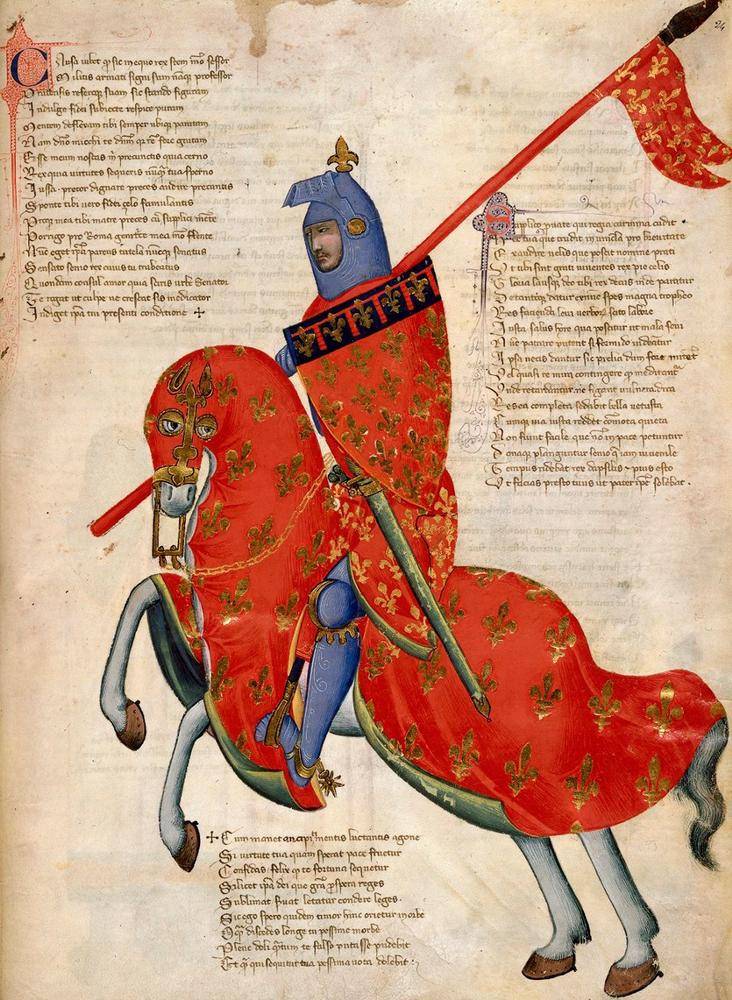
A wonderful image of a knight on a page from “Appeal in verse to Robert of Anjou, King of Naples, from the city of Prato in Tuscany” (“Regia Carmina”). Illustrator Pacino di Buonaguida, who worked in Florence, ca. 1300 - 1350 The book is dated 1335-1340. (British Library, London)
The subsequent wars of Frederick II had little effect on the military structure created by the Normans. True, the role of Sicilian Muslims in the Christian troops at the end of the XIII century was greatly reduced. At the same time, a number of interesting technical developments in weapons and armor appeared precisely in southern Italy, and already from here it spread to its central and northern areas.
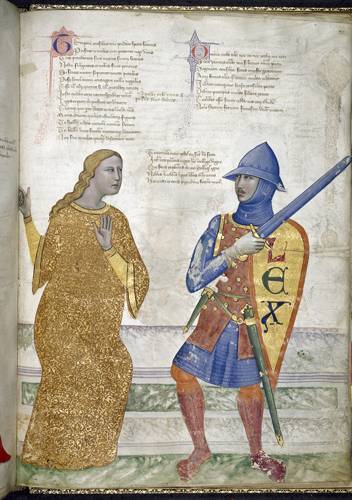
Another image of a knight from the same manuscript and the work of the same artist. The girl on the left depicts precaution. The warrior on the right is Justice. On his shield is the Latin inscription "Lex", that is, "Law." (British Library, London)
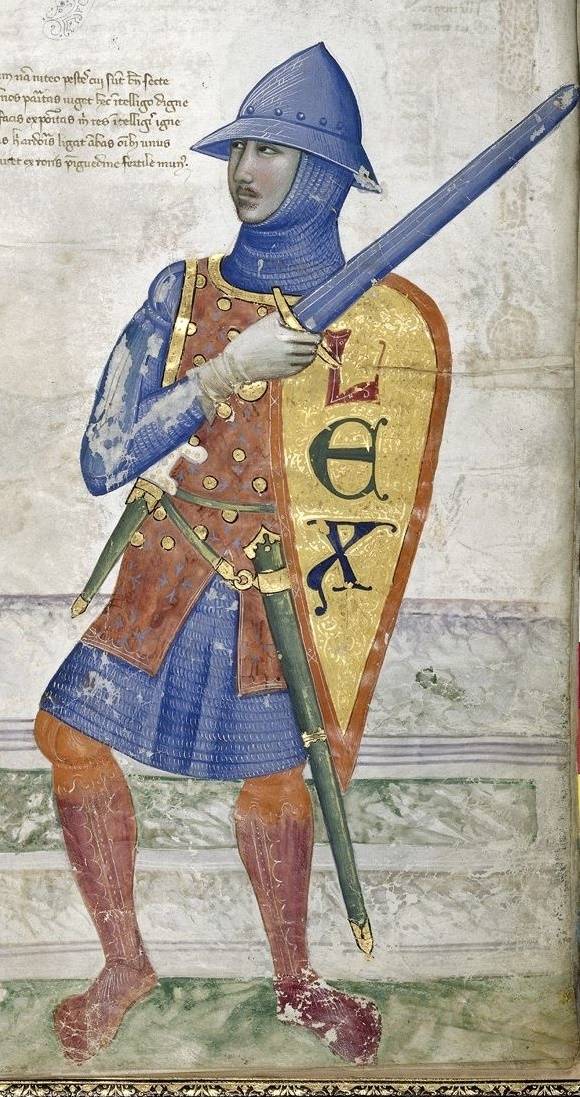
In its enlarged image, leather armor for legs with embossed on the skin, metal discs on the elbows and a brigandine lined with metal plates worn over the chain mail are clearly visible. On it we see gilded heads of rivets. A helmet-de-fer helmet (i.e., an iron hat), comfortable in a hot climate, complements its gear. The shield in the form of an "inverted drop" is clearly a Byzantine type. On the right on the belt is a basilard dagger with a bone handle.
It is believed that many of them clearly reflect the Islamic or Byzantine influence, although it is difficult to say what it was: the influence of Sicilian Muslims or Muslims from the African continent or those who lived in Palestine or Syria. For example, this concerns the use of relatively short piercing swords and large daggers in the 13th century, both with horse and bow riflemen, and infantry, and even knights. Another feature was the extensive use of invoice "armor" of hardened, "boiled leather" in the beginning and middle of the XIV century.
* On the opposition of Guelphs and Ghibellines will be discussed in one of the following articles.
** The following facts, for example, testify to the level of economic and social development of Italy: the first ever strike of hired workers in Florence took place in 1345, and in 1378, the Chompy sundry under the slogan “Long live the people and workshops! ”And what happened at this very time in Russia? Dmitry Donskoy won a victory on the river Vozh ... And no one has ever heard of any workshops!
Использованная литература:
1. Nicolle, D. Italian Medieval Armies 1000 – 1300. Oxford: Osprey (Men-at-Arms # XXNX), 376.
2. Nicolle, D. Arms and Armor of the Crusading Era, 1050 - 1350. UK L .: Greenhill Books. Vol. 1,1999.
3. Nicolle, D. Italian Militiaman 1260 – 1392. Oxford: Osprey (Warrior # 25), 1995.
4. Nicolle D. Italian Medieval Armies 1300 - 1500. L .: Osprey (Men-at-arms series No. 136), 1983.
5. Verbruggen during the Middle Ages from the Eight Century to 1340. Amsterdam - NY Oxford, 1977.
6. Backhouse, Janet. The Centuries of Manuscript Painting in the British Library. Canada, Toronto: University of Toronto Press, 1997.
7. Gravette, K., Nicole, D. Normans. Knights and Conquerors (Transl. From English A.Kolina) M .: Eksmo, 2007.
To be continued ...
- Vyacheslav Shpakovsky
- Knights and chivalry of three centuries. Part of 11. Knights of Italy 1050-1350.
Knights and chivalry of three centuries. Part of 10. Knights of the Kingdom of Arelat
Knights and chivalry of three centuries. Part of 9. Germanic effigii
Knights and chivalry of three centuries. Part of 8. Knights of the Holy Roman Empire
Knights and chivalry of three centuries. Part of 7. Knights of Spain: Leon, Castile and Portugal
Knights and chivalry of three centuries. Knights of Spain: Aragon, Navarre and Catalonia (part 6)
Knights and chivalry of three centuries. CH 5. Knights of France. Central and southern areas
Knights and chivalry of three centuries. Knights of Ireland (part 4)
Knights and chivalry of three centuries. Knights of Scotland (part 3)
Knights and chivalry of three centuries. Knighthood and knights of England and Wales. Part of 2
Knights and chivalry of three centuries. Knighthood and knights of northern France. Part of 1
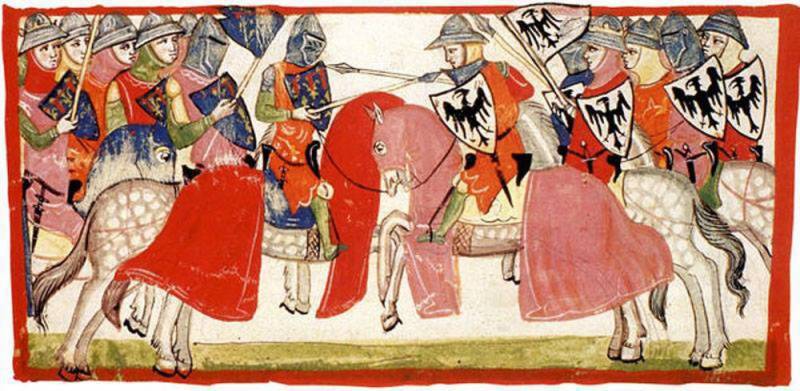
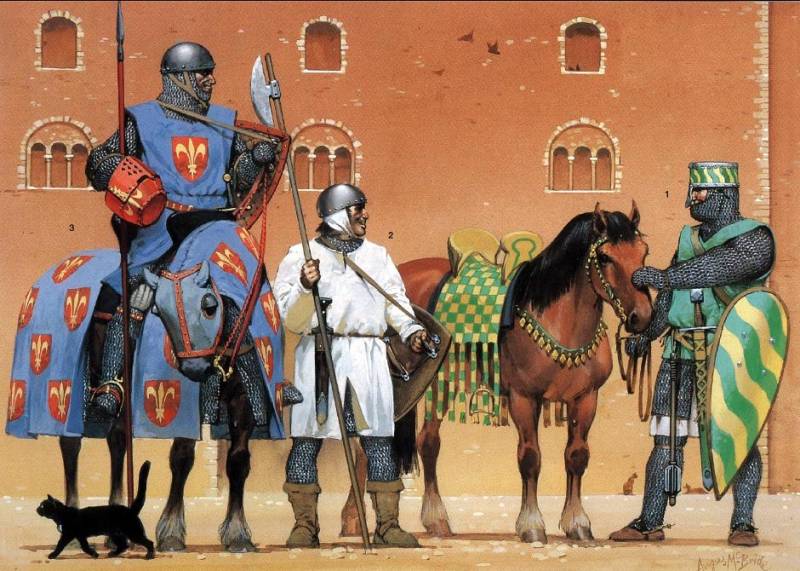
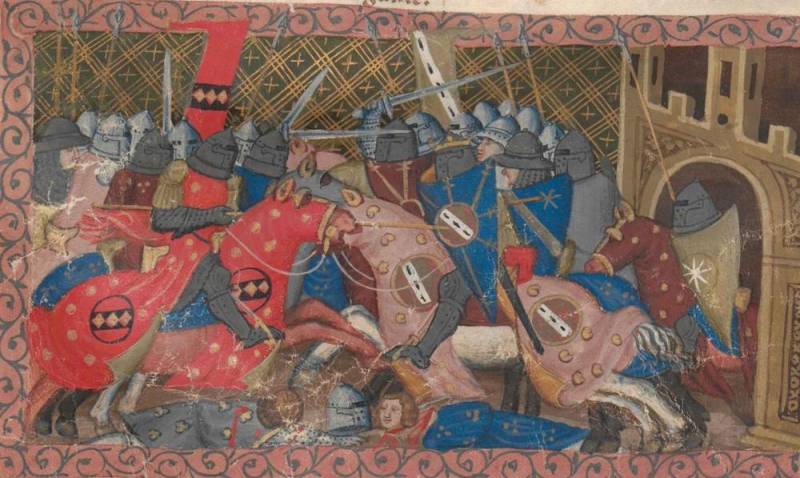
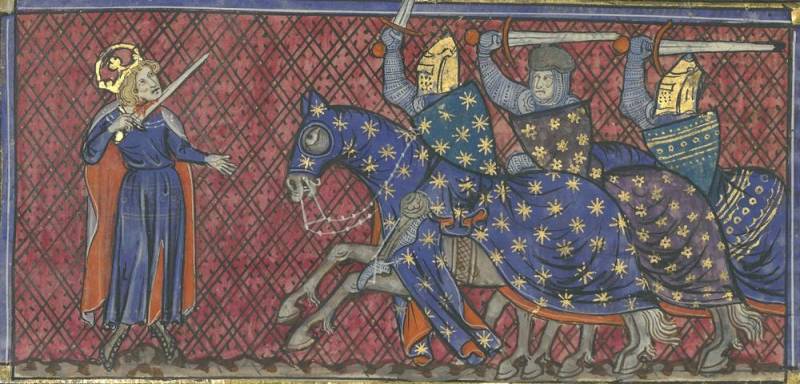
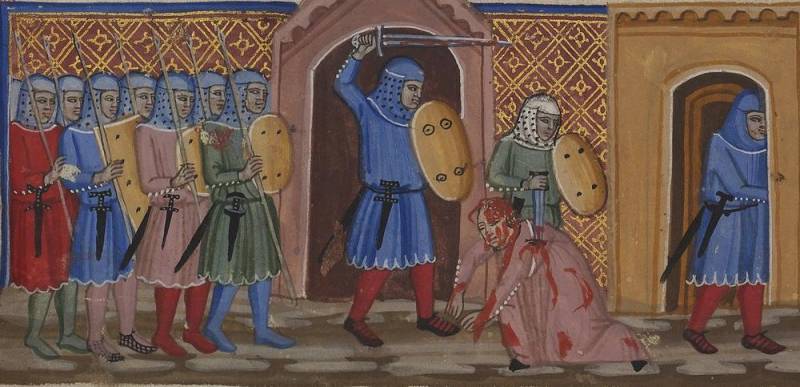
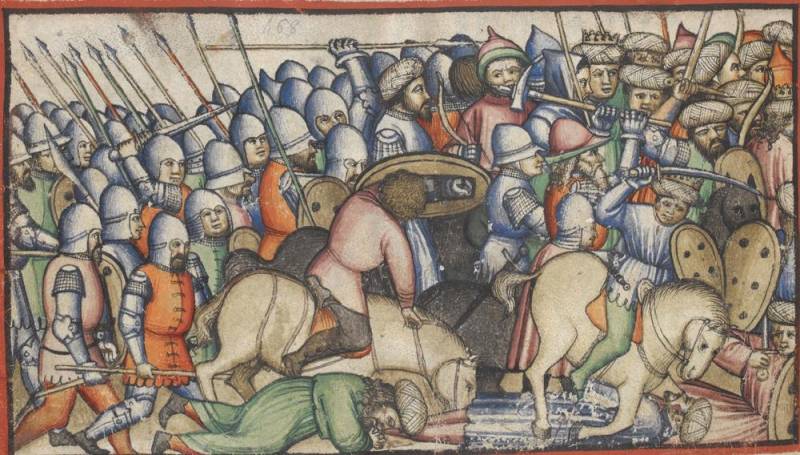
Information